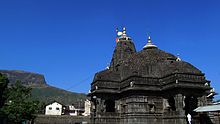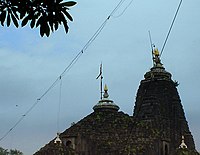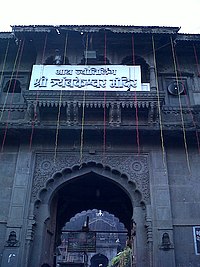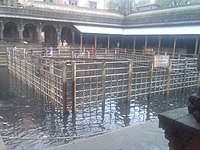Trimbakeshwar Shiva Temple
| Trimbakeshwar Shiva Temple | |
|---|---|
 | |
| Religion | |
| Affiliation | Hinduism |
| District | Nashik |
| Location | |
| Location | Trimbak |
| Country | |
| Architecture | |
| Type | Hemadpanthi |
| Creator | Balaji Baji Rao |
Trimbakeshwar or Tryambakeshwar is an ancient Hindu temple in the town of Trimbak, in the Trimbakeshwar tehsil in the Nashik District of Maharashtra, India, 28 km from the city of Nashik. It is dedicated to the god Shiva and is one of the twelve Jyotirlingas.
Kusavarta, a kunda (sacred pond) in the temple premises is the source of the Godavari River, the longest river in peninsular India. The current temple was built by Peshwa Balaji Baji Rao (Nanasaheb).

Jyotirlinga
As per the Shiva Purana, once Brahma (the Hindu God of creation) and Vishnu (the Hindu God of preservation) had an argument in terms of supremacy of creation.[1] To test them, Shiva pierced the three worlds as a huge endless pillar of light, the jyotirlinga. Vishnu and Brahma split their ways to downwards and upwards respectively to find the end of the light in either directions. Brahma lied that he found out the end, while Vishnu conceded his defeat. Shiva appeared as a second pillar of light and cursed Brahma that he would have no place in ceremonies while Vishnu would be worshipped till the end of eternity. The jyotirlinga is the supreme partless reality, out of which Shiva partly appears. The jyothirlinga shrines, thus are places where Shiva appeared as a fiery column of light.[2][3] Originally there were believed to be 64 jyotirlingas while 12 of them are considered to be very auspicious and holy.[1] Each of the twelve jyotirlinga sites take the name of the presiding deity - each considered different manifestation of Shiva.[4] At all these sites, the primary image is lingam representing the beginningless and endless Stambha pillar, symbolizing the infinite nature of Shiva.[4][5][6] The twelve jyothirlinga are Somnath in Gujarat, Mallikarjuna at Srisailam in Andhra Pradesh, Mahakaleswar at Ujjain in Madhya Pradesh, Omkareshwar in Madhya Pradesh, Kedarnath in Himalayas, Bhimashankar in Maharashtra, Viswanath at Varanasi in Uttar Pradesh, Trimbakeshwar in Maharashtra, Vaidyanath at Deoghar in Bihar, Nageshwar Temple, Aunda Nagnath ] in Maharashtra, Rameshwar at Rameswaram in Tamil Nadu and Grishneshwar at Aurangabad in Maharashtra.[1][7] it is made of pure stones and inside the temple sits lord shiva. This temple is in Nashik
Mythological History

Trimbakeshwar is a religious center having one of the twelve Jyotirlingas. The extraordinary feature of the Jyotirlinga located here is its three faces embodying Lord Brahma, Lord Vishnu and Lord Rudra. Due to excessive use of water, the linga has started to erode. It is said that this erosion symbolizes the eroding nature of human society. The Lingas are covered by a jeweled crown which is placed over the Gold Mask of Tridev (Brahma Vishnu Mahesh). The crown is said to be from the age of Pandavs and consists of diamonds, emeralds, and many precious stones. The crown is displayed every Monday from 4-5 pm (Shiva).
All other Jyotirlingas have Shiva as the main deity. The entire black stone temple is known for its appealing architecture and sculpture and is at the foothills of a mountain called Brahmagiri. Three sources of the Godavari originate from the Brahmagiri mountain.
Story related to the Godavari river

Brahmadev worshipped God Trivikram when he came to Satya Loka (on earth) with the same holy water of the Ganges, to get the river Ganges held up by God Shankar on his head, to flow. There was a famine of 24 years and people were affected by the pangs of hunger. However, Varun - the God of Rains, pleased with Sage Gautama arranged rains every day in Gautama's Ashram (dwelling place) which was in Trimbakeshwar. Gautama used to sow rice in the surrounding fields of his Ashram in the morning, reap the crop in the afternoon and with it fed a large group of rishis, who took shelter in his Ashram on account of the famine. The blessings of the group of rishis increased the merit (Punya) of Gautama. Lord Indra's position became shaky because of his increased merit. So Indra ordered clouds to rain all over Trimbakeshwar, so that the famine will be over and Rishis will go back and the increasing merits of Gautama will be weakened. Although the famine was over, Gautama urged the Rishis to stay back and kept on feeding them and gaining merit. Once he saw a cow grazing in the paddy field and he drove her away by throwing Darbha (sharp, pointed grass). The slender cow died by this. It was Jaya - Parvati's friend, who had taken the form of a cow. This news upset the Rishis and they refused to luncheon at his Ashram. Gautama requested Rishis to show a way out of this sin. He was advised to approach Lord Shiva and request him to release Ganges and a bath in the Ganges would set him free of his sins. Gautama then practiced penance by going to the peak of Brahmagiri. Lord Shankara was pleased by his worships and gave him the Ganges.

However, Ganges was not prepared to part with Lord Shiva, which irritated him. He made TandavNrutya (dance) on the peak of Brahmagiri and dashed his jata there. Frightened by this action, Ganges appeared on Brahmagiri. Later on Ganges appeared in the Trimbak Tirtha. Gautama praised her but she off and on appeared on the mountain at various places and disappeared in anger. Gautama could not bathe in her waters. Ganges then appeared in Gangadwar, Varaha-tirtha, Rama-Laxman tirtha, Ganga Sagar tirtha. Still Gautama could not bathe in her waters. The Gautama surrounded the river with enchanted grass and put a vow to her. The flow stopped there and the tirtha thus came to be called Kushavarta. It is from this Kushavarta that the river Godavari flows up to the sea. The sin of killing a cow by Gautama was wiped off here.
This place is famous for lots of religious rituals (vidhis). Narayan Nagbali, Kalsarpa Shanti, Tripindi vidhi are done here. Narayan Nagbali puja is performed at Trimbakeshwar only. This puja is performed in three days. This puja is performed on special dates. Some days are not suitable to perform this puja. This puja is performed for many reasons like to cure an illness, going through bad times, killing a Cobra (Nag), childless couples, financial crisis or you want to perform some religious puja to have everything.
Trimbakeshwar town has a large number of Brahmin households and is also a centre for Vedic Gurukuls (kind of boarding school). It also has ashrams and Muths devoted to Ashtanga Yoga, the Hindu art of living.
The existing temple was built out of basalt after it was commissioned by Peshwa Nanasaheb. It so happens that the Peshwa made a bet on whether the stone surrounding the Jyotirlinga, is hollow from the inside or not. The stone was proved to be hollow, and on losing the bet, the Peshwa built a marvelous temple out of it. The Shiva deity of the temple consisted of the world famous Nassak Diamond. It was appropriated by the British in The Third Anglo-Maratha War and lies with one owner or the other ever since. The diamond presently lies with Edward J. Hand, a trucking firm executive from Greenwich, Connecticut, USA
The place is known for its scenic beauty in rainy/monsoon season and is surrounded by lush green hills untouched by pollution. Anjaneri mountain, the birthplace of Lord Hanuman, is 7 km from Trimbakeshwar.
Shri Nilambika/Dattatreya/Matamba Temple
This temple is on top of the Neel mountain. All goddesses ('Matamba','Renuka','Mananmba') came here to see 'Parashuram' when he was performing penance (tapas). After his penance he requested all goddesses to stay there and the temple was formed for these goddesses. God Dattatreya दत्तात्रेय (Shripad Shrivallabh) stayed here for some years.as well as neelkantheshwar mahadev ancient mandir is also situated right behind the Dattatrey temple. & in the feets of this Neel parvat :Annapurna ashram,renuka devi,khandoba temple is also here.
Akhil Bhartiya Shree Swami Samarth Gurupeeth, Trimbakeshwar Temple of Shri Swami Samarth Maharaj. This Temple is 1 km far from Shiva Temple. This Temple is marvelous Example of Vastu Shashtra.
See also
References
Notes
- Chaturvedi, B. K. (2006), Shiv Purana (First ed.), New Delhi: Diamond Pocket Books (P) Ltd, ISBN 81-7182-721-7
- Eck, Diana L. (1999), Banaras, city of light (First ed.), New York: Columbia University Press, ISBN 0-231-11447-8
- Gwynne, Paul (2009), World Religions in Practice: A Comparative Introduction, Oxford: Blackwell Publication, ISBN 978-1-4051-6702-4
{{citation}}: Cite has empty unknown parameter:|coauthors=(help). - Harding, Elizabeth U. (1998). "God, the Father". Kali: The Black Goddess of Dakshineswar. Motilal Banarsidass. pp. 156–157. ISBN 978-81-208-1450-9.
{{cite book}}: Cite has empty unknown parameter:|coauthors=(help) - Lochtefeld, James G. (2002), The Illustrated Encyclopedia of Hinduism: A-M, Rosen Publishing Group, p. 122, ISBN 0-8239-3179-X
- R., Venugopalam (2003), Meditation: Any Time Any Where (First ed.), Delhi: B. Jain Publishers (P) Ltd., ISBN 81-8056-373-1
- Vivekananda, Swami. "The Paris Congress of the History of Religions". The Complete Works of Swami Vivekananda. Vol. Vol.4.
{{cite book}}:|volume=has extra text (help); External link in|chapterurl=|chapterurl=ignored (|chapter-url=suggested) (help)
External links
- http://www.trimbakeshwar.net/ Information about various puja at trimbakeshwar



